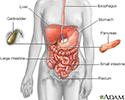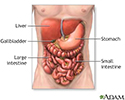Celiac disease – sprue
Sprue; Nontropical sprue; Gluten intolerance; Gluten-sensitive enteropathy; Celiac sprueCeliac disease is an autoimmune condition that damages the lining of the small intestine. This damage comes from a reaction to eating gluten. This is a substance that is found in wheat, rye, barley, and possibly oats. It is also found in food made from these ingredients.
The damaged intestine is not able to fully absorb nutrients from food.
Causes
The exact cause of celiac disease is not known. The lining of the intestines have small areas called villi which project outward into the opening of the intestine. These structures help absorb nutrients.
When people with celiac disease eat foods with gluten, their immune system reacts by damaging the villi. Because of the damage, the villi are unable to properly absorb iron, vitamins, and other nutrients. This may cause a number of symptoms and other health problems.
The disease can develop at any point in life, from infancy to late adulthood.
People who have a family member with celiac disease are at greater risk of developing the disease. The disorder is most common in Europeans.
People with celiac disease are more likely to have:
- Autoimmune disorders such as rheumatoid arthritis, systemic lupus erythematosus, and Sjögren syndrome
Systemic lupus erythematosus
Systemic lupus erythematosus (SLE) is an autoimmune disease. In this disease, the immune system of the body mistakenly attacks healthy tissue. It c...
 ImageRead Article Now Book Mark Article
ImageRead Article Now Book Mark ArticleSjögren syndrome
Sjögren syndrome is an autoimmune disorder in which the glands that produce tears and saliva are destroyed. This causes dry mouth and dry eyes. The...
 ImageRead Article Now Book Mark Article
ImageRead Article Now Book Mark Article -
Addison disease
Addison disease
Addison disease is a disorder that causes the adrenal glands to not produce enough hormones.
 ImageRead Article Now Book Mark Article
ImageRead Article Now Book Mark Article - Down syndrome
- Intestinal cancer
- Intestinal lymphoma
-
Lactose intolerance
Lactose intolerance
Lactose is a type of sugar found in milk and other dairy products. An enzyme called lactase is needed by the body to digest lactose. Lactose intoler...
 ImageRead Article Now Book Mark Article
ImageRead Article Now Book Mark Article - Thyroid disease
-
Type 1 diabetes
Type 1 diabetes
Type 1 diabetes is a lifelong (chronic) disease in which there is a high level of sugar (glucose) in the blood.
 ImageRead Article Now Book Mark Article
ImageRead Article Now Book Mark Article
Symptoms
The symptoms of celiac disease can be different from person to person. This can make diagnosis difficult. For example, one person may have constipation, a second may have diarrhea, and a third may have no problem with stools.
Gastrointestinal symptoms include:
-
Abdominal pain, bloating, gas, or indigestion
Abdominal pain
Abdominal pain is pain that you feel anywhere between your chest and groin. This is often referred to as the stomach region or belly.
 ImageRead Article Now Book Mark Article
ImageRead Article Now Book Mark Article - Constipation
-
Decreased appetite (may also be increased or unchanged)
Decreased appetite
A decreased appetite is when your desire to eat is reduced. The medical term for a loss of appetite is anorexia.
 ImageRead Article Now Book Mark Article
ImageRead Article Now Book Mark Article - Diarrhea, either constant or off and on
-
Lactose intolerance (common when the person is diagnosed, often goes away after treatment)
Lactose intolerance
Lactose is a type of sugar found in milk and other dairy products. An enzyme called lactase is needed by the body to digest lactose. Lactose intoler...
 ImageRead Article Now Book Mark Article
ImageRead Article Now Book Mark Article -
Nausea and vomiting
Nausea and vomiting
Nausea is feeling an urge to vomit. It is often called "being sick to your stomach. "Vomiting or throwing-up forces the contents of the stomach up t...
 ImageRead Article Now Book Mark Article
ImageRead Article Now Book Mark Article - Stools that are foul smelling, oily, or stick to the toilet when flushed
-
Unexplained weight loss (although people can be overweight or normal weight)
Unexplained weight loss
Unexplained weight loss is a decrease in body weight, when you did not try to lose the weight on your own. Many people gain and lose weight. Uninten...
Read Article Now Book Mark Article
Other problems that can develop over time because the intestines do not absorb key nutrients include:
- Easy bruising
-
Depression or anxiety
Depression
Depression may be described as feeling sad, blue, unhappy, miserable, or down in the dumps. Most of us feel this way at one time or another for shor...
 ImageRead Article Now Book Mark Article
ImageRead Article Now Book Mark Article -
Fatigue
Fatigue
Fatigue is a feeling of weariness, tiredness, or lack of energy.
 ImageRead Article Now Book Mark Article
ImageRead Article Now Book Mark Article - Growth delay in children
- Hair loss
- Itchy skin with a rash (dermatitis herpetiformis)
Dermatitis herpetiformis
Dermatitis herpetiformis (DH) is a very itchy rash consisting of bumps and blisters. The rash is chronic (long-term).
 ImageRead Article Now Book Mark Article
ImageRead Article Now Book Mark Article - Missed menstrual periods
- Mouth ulcers
- Muscle cramps and joint pain
- Nosebleeds
-
Seizures
Seizures
A seizure is the physical changes in behavior that occurs during an episode of specific types of abnormal electrical activity in the brain. The term ...
 ImageRead Article Now Book Mark Article
ImageRead Article Now Book Mark Article - Tingling or numbness in the hands or feet
- Unexplained short height
Children with celiac disease may have:
- Defects in the tooth enamel and changes in tooth color
- Delayed puberty
- Muscle wasting
- Diarrhea, constipation, fatty or foul-smelling stools, nausea, or vomiting
- Irritable and fussy behavior
- Poor weight gain
- Slowed growth and shorter than normal height for their age
Exams and Tests
The following tests may be performed:
- Bone density
- Cholesterol (may be low)
- Complete blood count (CBC - test for anemia)
CBC
A complete blood count (CBC) test measures the following:The number of white blood cells (WBC count)The number of red blood cells (RBC count)The numb...
 ImageRead Article Now Book Mark Article
ImageRead Article Now Book Mark Article - Comprehensive metabolic panel
- Folate level (serum)
- Iron level (serum)
- Ferritin level (serum)
-
Prothrombin time
Prothrombin time
Prothrombin time (PT) is a blood test that measures the time it takes for the liquid portion (plasma) of your blood to clot. It measures the functio...
 ImageRead Article Now Book Mark Article
ImageRead Article Now Book Mark Article - Vitamin B12 level (serum)
- Vitamin D level (serum)
Blood tests can detect antibodies, called antitissue transglutaminase antibodies (tTGA) or anti-endomysial antibodies (EMA) which may help detect the condition. The health care provider will order these antibody tests if celiac disease is suspected.
If the tests are positive, upper endoscopy is often performed to sample a piece of tissue (biopsy) from the first part of the small intestine (duodenum). The biopsy may show a flattening or loss of the villi in the parts of the intestine affected in the duodenum.
Endoscopy
Endoscopy is a way of looking inside the body using a flexible tube that has a small camera and light on the end of it. This instrument is called an...

Genetic testing of the blood can also be done to help detect who may be at risk for celiac disease. Those who test negative for the common genetic variant are unlikely to have celiac disease.
A follow-up biopsy or blood test may be ordered several months after the diagnosis and treatment. These tests assess how well treatment is working. Normal results mean that you have responded to treatment. This confirms the diagnosis. However, this does not mean that the disease has been cured.
Treatment
Celiac disease cannot be cured. Your symptoms will go away and the villi in the intestines will heal if you follow a lifelong gluten-free diet. Do not eat foods, drink beverages, or take medicines that contain wheat, barley, rye, and possibly oats.
Gluten-free diet
Celiac disease is an immune disorder passed down through families. Gluten is a protein found in wheat, barley, or rye. It may also be found in some ...

You must read food and drug labels carefully to look for ingredients that may include these grains. It may be hard to stick to a gluten-free diet because wheat and barley grains are common in the American diet. Over time, most people are able to adapt and get better. You should NOT begin the gluten-free diet before you are diagnosed. Starting the diet will affect testing for the disease.
In most cases, following a well-balanced, gluten-free diet is the only treatment you need to stay well. Your provider may need to prescribe vitamin and mineral supplements.
Sometimes, short-term use of corticosteroids (such as prednisone) may be needed if celiac disease does not respond to treatment.
When you are diagnosed, get help from a registered dietitian who specializes in celiac disease and the gluten-free diet. A support group may also help you cope with the disease and diet.
Support group
If you have celiac disease, it is very important that you receive counseling from a registered dietitian who specializes in celiac disease and gluten...

Support Groups
You can ease the stress of illness by joining a support group. More information and support for people with celiac disease and their families can be found at the National Celiac Association.
Outlook (Prognosis)
Following a gluten-free diet heals the damage to the intestines and prevents further damage. This healing most often occurs within 3 to 6 months in children. Recovery may take 2 to 3 years in adults.
Rarely, long-term damage will be done to the lining of the intestines before the diagnosis is made.
Some problems caused by celiac disease may not improve, such as a short height and damage to the teeth.
Possible Complications
You must carefully continue to follow the gluten-free diet. When untreated, the disease can cause fatal complications.
Delaying diagnosis or not following the diet puts you at risk for related conditions such as:
- Autoimmune disorders
- Bone disease (osteoporosis, kyphoscoliosis, fractures)
Osteoporosis
Osteoporosis is a disease in which bones become fragile and more likely to break (fracture).
 ImageRead Article Now Book Mark Article
ImageRead Article Now Book Mark ArticleKyphoscoliosis
Scoliosis is an abnormal curving of the spine. Your spine is your backbone. It runs straight down your back. Everyone's spine naturally curves a b...
 ImageRead Article Now Book Mark Article
ImageRead Article Now Book Mark Article - Certain types of intestinal cancer
- Low blood count (anemia)
Anemia
Anemia is a condition in which the body does not have enough healthy red blood cells. Red blood cells provide oxygen to body tissues. Different type...
 ImageRead Article Now Book Mark Article
ImageRead Article Now Book Mark Article -
Infertility or repeated miscarriage
Infertility
Infertility means you cannot get pregnant (conceive). There are 2 types of infertility:Primary infertility refers to couples who have not become preg...
 ImageRead Article Now Book Mark Article
ImageRead Article Now Book Mark ArticleMiscarriage
A miscarriage is the spontaneous loss of a fetus before the 20th week of pregnancy. Pregnancy losses after the 20th week are called stillbirths. Mi...
 ImageRead Article Now Book Mark Article
ImageRead Article Now Book Mark Article - Liver disease
When to Contact a Medical Professional
Contact your provider if you have symptoms of celiac disease.
Prevention
Because the exact cause is not known, there is no way to prevent the development of celiac disease. However, you should be aware of the risk factors such as family history. This may increase your chances of early diagnosis and treatment.
References
Lebwohl B, Green PHR. Celiac disease. In: Feldman M, Friedman LS, Brandt LJ, eds. Sleisenger and Fordtran's Gastrointestinal and Liver Disease. 11th ed. Philadelphia, PA: Elsevier; 2021:chap 107.
Lin JC, Benz EJ Jr. Approach to anemia in the adult and child. In: Hoffman R, Benz EJ, Silberstein LE, et al, eds. Hematology: Basic Principles and Practice. 8th ed. Philadelphia, PA: Elsevier; 2023:chap 35.
Rubio-Tapia A, Hill ID, Semrad C, et al. American College of Gastroenterology guidelines update: diagnosis and management of celiac disease. Am J Gastroenterol. 2023;118(1):59-76. PMID: 36602836 pubmed.ncbi.nlm.nih.gov/36602836/.
Schiller LR. Malabsorption. In: Kellerman RD, Rakel DP, Heidelbaugh JJ, Lee EM, eds. Conn's Current Therapy 2024. Philadelphia, PA: Elsevier; 2024:273-279.
Semrad CE. Approach to the patient with diarrhea and malabsorption. In: Goldman L, Cooney KA, eds. Goldman-Cecil Medicine. 27th ed. Philadelphia, PA: Elsevier; 2024:chap 126.
-
Celiac disease - illustration
The intestinal lining has small hair-like projections called villi, which help absorb nutrients. When people with celiac disease eat foods with gluten, it triggers an immune response. Over time, the inflammation caused by the immune response damages the villi. Because of the damage, the villi are unable to properly absorb iron, vitamins, and other nutrients. This may cause a number of symptoms, including diarrhea, fatigue, and weight loss, as well as a number of other health problems.
Celiac disease
illustration
-
Digestive system - illustration
The esophagus, stomach, large and small intestine, aided by the liver, gallbladder and pancreas convert the nutritive components of food into energy and break down the non-nutritive components into waste to be excreted.
Digestive system
illustration
-
Celiac sprue - foods to avoid - illustration
Celiac disease causes inflammation in the small intestine and damage in the lining. This prevents the body from properly absorbing the nutrients in food. The damage to the lining of the intestine comes from a reaction to eating gluten, which is found in wheat, rye, barley, and contaminated oats, and in food made from these ingredients. The inability to absorb nutrients can lead to weight loss, fatigue, malnourishment, and other health problems. Gluten may be found in many foods, especially processed foods and baked goods. Breads, cakes, desserts, alcoholic beverages (except wine), cereals, and pastas may all contain gluten. Eating a gluten-free diet heals the intestines and prevents further damage.
Celiac sprue - foods to avoid
illustration
-
Dermatitis - herpetiformis on the knee - illustration
This picture shows the knee of a person with a chronic inflammatory disease known as dermatitis herpetiformis. It produces red, raised (papular), small or large blisters (vesicles or bullae) that burn and itch intensely. Dermatitis herpetiformis develops suddenly, lasts for weeks to months, and may be associated with digestive diseases (such as Celiac disease).
Dermatitis - herpetiformis on the knee
illustration
-
Dermatitis - herpetiformis on the arm and legs - illustration
This picture shows a chronic inflammatory disease (dermatitis herpetiformis) that produces red (erythematous), raised (papular), small or large blisters (vesicles or bullae) that burn and itch intensely. Dermatitis herpetiformis develops suddenly, lasts for weeks to months, and may be associated with digestive diseases (such as Celiac disease).
Dermatitis - herpetiformis on the arm and legs
illustration
-
Digestive system organs - illustration
The digestive system organs in the abdominal cavity include the liver, gallbladder, stomach, small intestine and large intestine.
Digestive system organs
illustration
-
Celiac disease - illustration
The intestinal lining has small hair-like projections called villi, which help absorb nutrients. When people with celiac disease eat foods with gluten, it triggers an immune response. Over time, the inflammation caused by the immune response damages the villi. Because of the damage, the villi are unable to properly absorb iron, vitamins, and other nutrients. This may cause a number of symptoms, including diarrhea, fatigue, and weight loss, as well as a number of other health problems.
Celiac disease
illustration
-
Digestive system - illustration
The esophagus, stomach, large and small intestine, aided by the liver, gallbladder and pancreas convert the nutritive components of food into energy and break down the non-nutritive components into waste to be excreted.
Digestive system
illustration
-
Celiac sprue - foods to avoid - illustration
Celiac disease causes inflammation in the small intestine and damage in the lining. This prevents the body from properly absorbing the nutrients in food. The damage to the lining of the intestine comes from a reaction to eating gluten, which is found in wheat, rye, barley, and contaminated oats, and in food made from these ingredients. The inability to absorb nutrients can lead to weight loss, fatigue, malnourishment, and other health problems. Gluten may be found in many foods, especially processed foods and baked goods. Breads, cakes, desserts, alcoholic beverages (except wine), cereals, and pastas may all contain gluten. Eating a gluten-free diet heals the intestines and prevents further damage.
Celiac sprue - foods to avoid
illustration
-
Dermatitis - herpetiformis on the knee - illustration
This picture shows the knee of a person with a chronic inflammatory disease known as dermatitis herpetiformis. It produces red, raised (papular), small or large blisters (vesicles or bullae) that burn and itch intensely. Dermatitis herpetiformis develops suddenly, lasts for weeks to months, and may be associated with digestive diseases (such as Celiac disease).
Dermatitis - herpetiformis on the knee
illustration
-
Dermatitis - herpetiformis on the arm and legs - illustration
This picture shows a chronic inflammatory disease (dermatitis herpetiformis) that produces red (erythematous), raised (papular), small or large blisters (vesicles or bullae) that burn and itch intensely. Dermatitis herpetiformis develops suddenly, lasts for weeks to months, and may be associated with digestive diseases (such as Celiac disease).
Dermatitis - herpetiformis on the arm and legs
illustration
-
Digestive system organs - illustration
The digestive system organs in the abdominal cavity include the liver, gallbladder, stomach, small intestine and large intestine.
Digestive system organs
illustration
Review Date: 3/31/2024
Reviewed By: Jenifer K. Lehrer, MD, Department of Gastroenterology, Aria - Jefferson Health Torresdale, Jefferson Digestive Diseases Network, Philadelphia, PA. Review provided by VeriMed Healthcare Network. Also reviewed by David C. Dugdale, MD, Medical Director, Brenda Conaway, Editorial Director, and the A.D.A.M. Editorial team.









